By Marcin Wojtyczka
18 minutes readMOB technique that works in most conditions and points of sails.
Most of us go sailing to relax and enjoy some time afloat. The majority of the “Man Overboard (MOB)” cases do not involve bad weather or rough seas. “Most happen on relatively calm waters, on a small boat under 22 feet in length that is not going very fast,” said Chris Edmonston, president of the BoatUS Foundation. “Victims tend to be men. Fishing is a prime activity, and in many cases, alcohol is involved”.
The MOB is generally quite rare but when it happens you should know exactly what to do. It does not matter how you get to the MOB as long as you do so safely and as quickly as possible. There are a few proven methods available which are well worth studying to work out which works best for your boat.
MOB prevention
It should be a high priority for every skipper and boat owner to prevent MOB in the first place. “Man Overboard” are the two words no one on any boat ever wants to hear. All sailing schools are teaching MOB methods and many offshore races require participants to practice MOB recoveries before the start. Unfortunately, very little is mentioned about how to not go overboard in the first place. Below are some of the best prevention methods that you should be familiar with.
Remember the traditional mariner's rule: "One hand for yourself, one hand for the ship!"
Ensure steady footing
Keep your centre of gravity low and use handholds (grabrails, stanchions, bow and stern pulpits). Do not go until you have a firm grip on something that will not give way. Look for tripping hazards on deck before you proceed. Always face the direction in which you are moving and keep a grasp on handholds. Always go forward and aft on the windward (uphill) side, where you are visible to others and where, if you fall, you are more likely to land on the boat than in the water. Use shoes that are not slippery on a wet deck. If you need to go to the bow, crawl to get there in more difficult conditions.
In most MOB incidents, one of these was forgotten at the moment. We all have forgotten to hold on or clip on when changing out a sail and performing simple tasks.
As a skipper, you should avoid tacking with crew on the foredeck. Tell the crew to use the heads at sea, not the side rail or the transom.
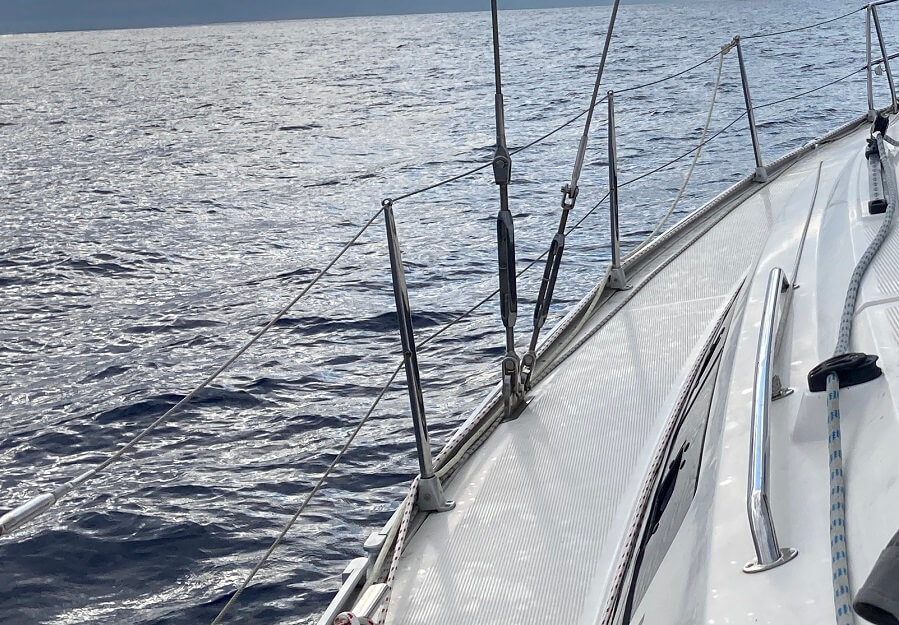
Wear a lifejacket and clip on
A good practice is to wear auto-inflation life jackets (160 NM of buoyancy with sprayhood, light, whistle and crotch straps) in harder conditions and at night. Based on statistics most fatal accidents happen because people did not wear PFD, so you must have a good reason not to wear it. The inflatable life jackets are great because they are comfortable to wear, and they include a harness as part of their design, so they can serve as a safety harness as well as a life jacket. They address the two biggest safety problems: staying on board and staying afloat. If you want to buy a life jacket, we can recommend Crewsaver and Spinlock brands.
In rough weather, at night, and whenever you feel unstable clip on a harness tether (lifeline) to a secure attachment point in the cockpit or a jackstay, not onto the guard rails. In rough weather, you should clip on before you exit the companionway. Always try to keep the tether as short as possible so that if you do slip, you will fall onto the deck and not over the side. Last but not least, always hook on to the windward (uphill) side.
Always maintain your life jacket carefully. Inspect the mechanisms with care to make sure they move easily. You can measure the weight of CO2 to ensure it contains the right amount of gas and have no leaks. Try to replace cartridges and automatic triggers according to manufacturers’ instructions. Check for leaks by inflating PDF orally and leaving it inflated for a few days. Store life jackets in dry places. Have a backup set of cartridges on hand at home and in the boat.
Fit and use jackstays
Jackstays are great to ensure you stay on board. You can hook your tether (lifeline) on a jackstay and move from bow to stern. Jackstays should be rigged along the centreline of the boat, not on the side. This will ensure that any fall is on deck and not overboard. Unfortunately, jackstays on most boats are set up to run on the sides so even when you are clipped on, you can still go over the side and inflict injury. In addition to that it is a good idea to have jackstays or strong secure points in the cockpit. You can find an excellent article on that topic in this Yachting Monthly article.
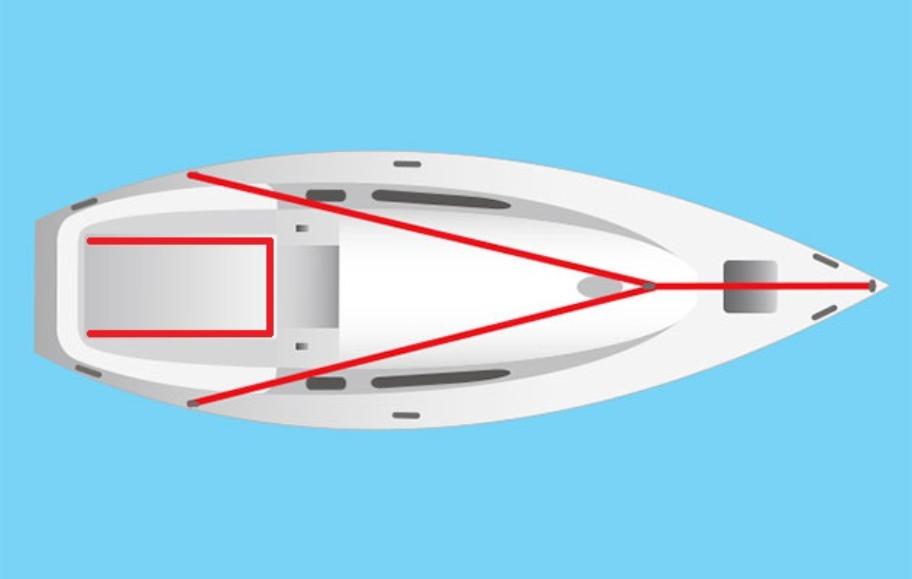
Install preventer for the mainsail
A swinging boom has terrific force and can inflict rig failure and crew injury. The very best solution is to prevent the boom from swinging across the boat by holding it in place with a preventer line. This line leads from the boom forward to a block on the bow via a block or low friction ring, and then back to the cockpit, so it can be adjusted easily on a winch or cleated. You should always set it up on a reach and when running where the uncontrolled gybe is most likely. Leading the preventer to run back to the cockpit allows it to be adjusted without anyone going forward. For that reason, the preventer should be rigged on both sides of the boat to allow the boom to be jibed without trouble.
Fixed preventer lines will cross the deck and get in the way, so it might be better to split the setup. Make a strop/lanyard (Dyneema or double braid polyester line) around two-thirds of the length of the boom with an eye splice at the end. One end can be permanently attached at the end of the boom and the other end will be tied to the running part of the preventer line (e.g. via bowline or sheet bend). The preventer lines will be prepared on each side with one end secured on the mid-ship cleat and the other run to the cockpit. The strop can be accessed easily from within the footprint of the deck while the mainsail is out so that you can switch preventers when gybing. Lines should be long enough that preventer set on one side can remain in place through a gybe. When not in use, the strop can be tensioned with an elastic cord from either the vang fitting or inboard boom casting.
The preventer should be attached to the outboard end of the boom to avoid breaking the tube in the event of an accidental gybe. In big waves, the flat angle makes the pull mostly forward and not down so that you avoid dragging the boom in the water.
Some boom end castings have a designated hole through which a preventer can be attached. Otherwise, pass a large bowline loop around the end of the boom between the clew and the end casting.
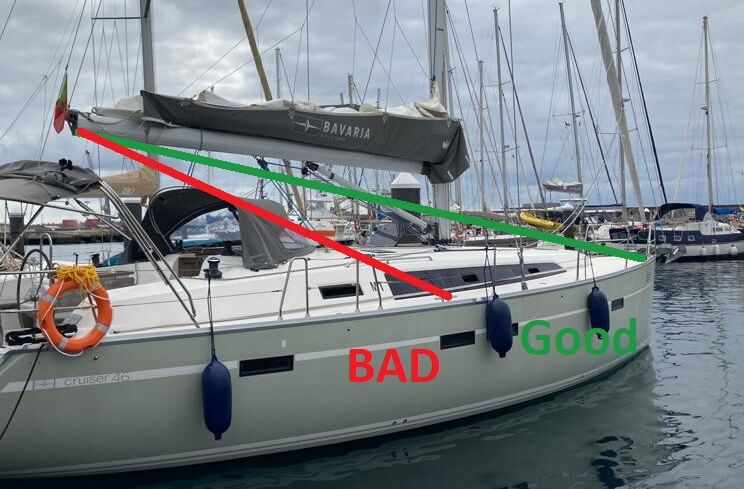
MOB rescue
There are several ways to get a person back on board. All these methods like figure eight and quick stop are great, but they only work up to moderate conditions. They are impractical in heavy weather, large waves, darkness, limited visibility, fog, rain, or with only one crew member remaining on board. The methods presented below should work in most conditions and any point of sails.
The steps are listed numerically, but the order will depend on the number and experience of your crew, the sea and the weather conditions you face. The skipper or the most senior person should take charge of the yacht. He or she should endeavour to carry out manoeuvres and delegate the tasks and actions to their crew ensuring they clearly understand the tasks they are given. The skipper must create an air of calm and order, because panic will, without doubt, hugely reduce the effectiveness of the rescue.
If someone goes overboard, remember to save the MOB GPS position and stop the boat immediately! This is essential in order to keep the casualty "in view".
Procedure
- Shout “Man Overboard” - Whoever first spotted someone going overboard should alert the rest of the crew.
- Press the MOB button on your GPS and check that you have a track running - This saves the present position as a waypoint that you can always steer back to in case you lose sight of the casualty. Ideally, you should be able to do it from the cockpit so that you do not have to go below deck.
- The person spotting the MOB point in the direction of the MOB - When another crew member gets on board it can take the role of spotter and point at the casualty meanwhile reporting distance. The spotter should keep pointing and not lose sight of the MOB.
- Captain or the most senior person takes charge of the yacht
- Immediately disengage the autopilot and heave-to (sheet in the main sail, turn the boat to windward and tack it without releasing jib, turn the wheel to windward) - You will stay upwind, almost in a stationary position and in visual contact with the MOB so that you can get yourself sorted. Start the engine if you cannot tack the boat with the sails. If you do not carry a foresail, on some boats you can also heave-to with the main sail alone. If you are under the engine immediately stop the prop and turn toward the side the MOB went over, in order to swing the stern and props away from the victim.. Under cruising chute or spinnaker in light winds, execute a controlled drop or a furl if top-down furler. If you’re under the spinnaker in strong winds, release all 3 corners and steer away from the sail, ensuring that before you do release the sail, you have changed course from dead downwind so that you do not run over the spinnaker in the water.
- Toss buoyancy (horseshoe, lifering, lifebelt, cushions) and mark the MOB position (dan buoy; floating lantern or light-sticks at night) - This will provide additional buoyancy and visibility of the casualty. Anything that you pass will be blown towards the MOB because you should be upwind of the MOB at this point.
- Send a DSC distress alert and a Mayday on channel 16 - Do that unless the conditions are mild, and you are sure you can easily recover the MOB. When sailing shorthanded use handheld VHF radio kept in the cockpit so that you do not have to go below deck.
- Check there are no lines overboard and start the engine - You have to take a few seconds before you start the engine to make sure there are no ropes overboard. You definitely do not want to foul the propeller. You can start the engine only after retrieving any warps from the water. Alternatively, proceed with rescue under sails.
- Make recovery decision and prepare recovery equipment - This will depend on wind & wave conditions, injuries, crew remaining onboard etc.
- Furl or drop the foresail - You can leave the mainsail so that you can retain control of the boat in case of engine failure.
- Approach the MOB upwind (keep 1-2 boat lengths) and toss a retrieving line (lifesling or floating heaving line with a bowline at the end) - If needed power through the waves to manoeuvre near the MOB. Watch out for any lines in the water near the casualty, and disengage the propeller when in doubt.
- Recover the MOB (e.g. lifesling) - See the next section.
- If required, apply first aid and call MRCC for medical advice
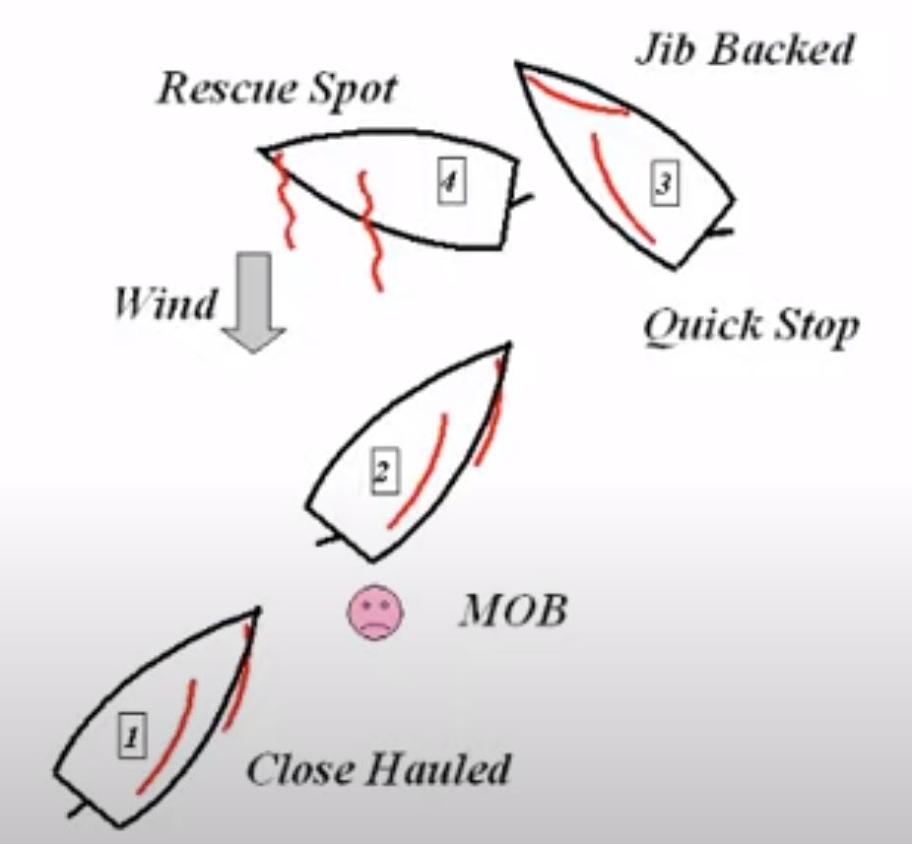
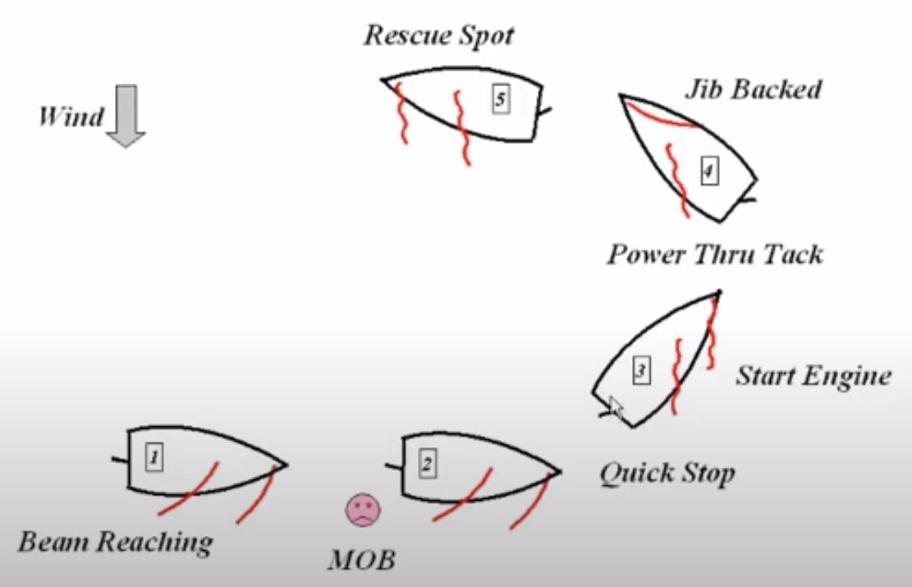
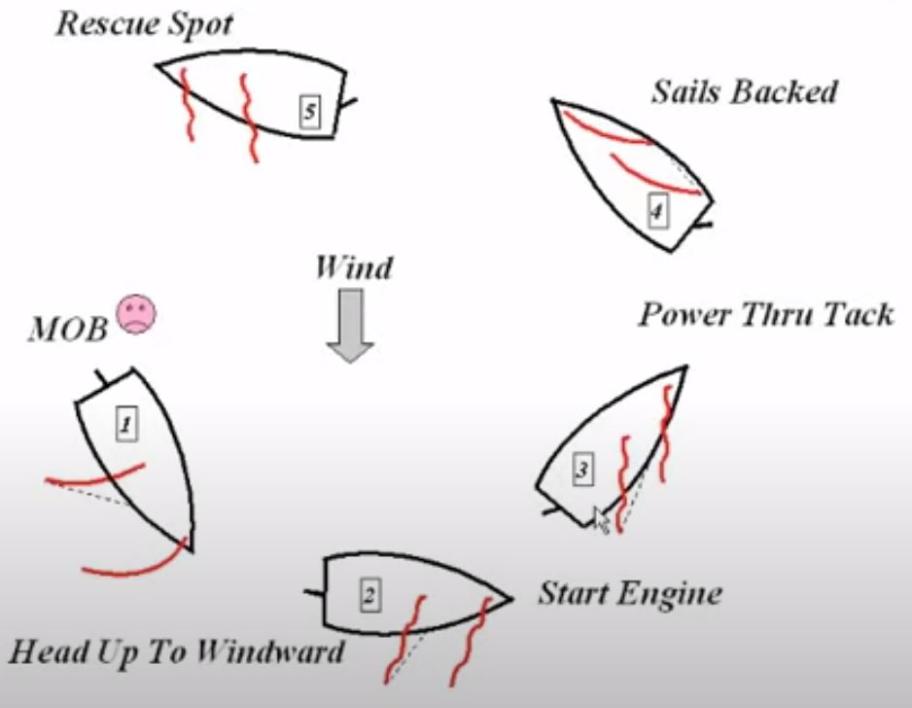
If you have a poled-out front sail (e.g. genua, chute, spinnaker), you should turn the boat downwind and gybe the mainsail first so that you do not have to deal with the whisker pole. This is followed by heave-to manoeuvre as before. If you carry a cruising chute or spinnaker in light winds, execute a controlled drop or furl with a top-down furler. If you are under the spinnaker in strong winds, release all 3 corners and steer away from the sail, ensuring that before you do release the sail, you have changed course from dead downwind so that you do not run over the spinnaker in the water.
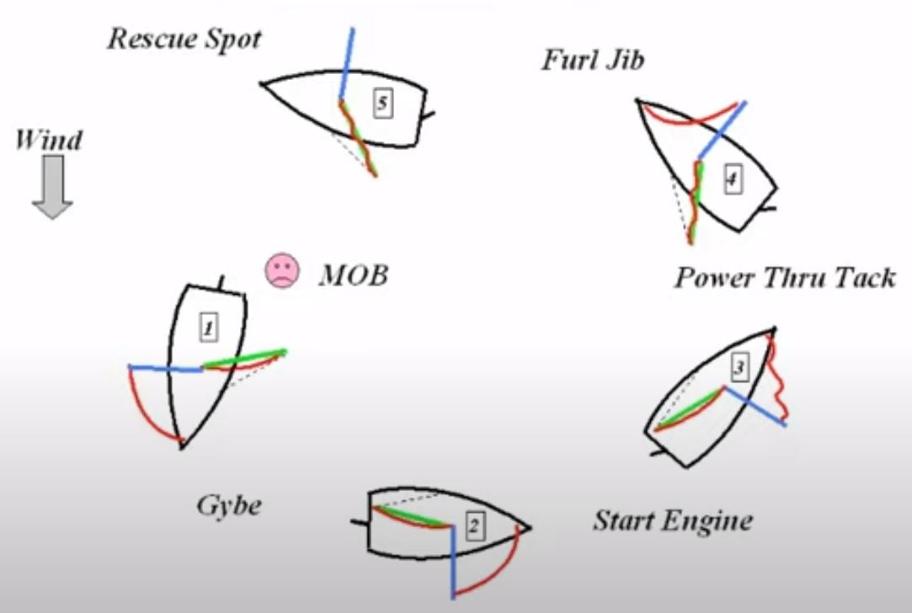
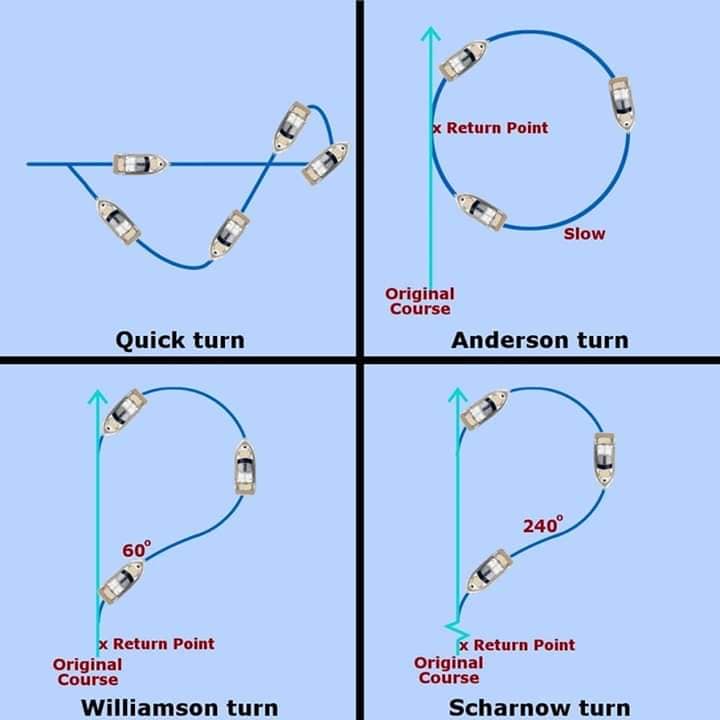
Excellent videos on MOB techniques can be found on Practical Boat Owner and Maryland School of Sailing.
MOB recovery
Approach
How to bring MOB aboard is often the most difficult part of the rescue. Each skipper must decide on the final approach to the person in the water based on the “on-scene” conditions at his or her location. The best preparation will be knowledge of your own specific boat - bare hull and heave-to characteristics in different wind and sea states.
It is dangerous to come alongside the MOB, especially in rough seas so keep 1-2 boat lengths from the MOB and throw him a line. In most situations, it is safest to approach the victim with your bow facing into the wind and waves. On a smaller boat without a lot of windage, it may be safer to come to a controlled stop upwind of the MOB and drift down on him.
You may need to change your strategy in a narrow channel, in large waves, near obstructions, or in other circumstances where manoeuvrability is limited. To prepare for these situations, practice a very slow approach with the wind and sea behind you.
The windward (upwind) approach:
Pros:
- The boat will drift down to the person (better control).
- Less chance of drifting away from the person.
- Blocks wind and waves to create a “calm” for recovery.
- Flotation can be thrown and assisted by wind and waves.
- Easier to launch dinghy or inflatable if necessary for recovery.
- Maybe a better choice if the victim is unconscious and unable to assist.
Cons:
- The boat could slam into a person in a seaway (rise and fall).
- The boat could push a person beneath the boat.
- Requires a fast, efficient recovery system to avoid injury.
The leeward (downwind) approach:
Pros:
- Sail closer to the victim for recovery.
- Protects the person from severe injury in a seaway.
Cons:
- Must come closer to the person for recovery.
- The boat could drift away from the person before recovery is completed.
- Flotation and rescue equipment must be tossed upwind.
- May require that you make a second attempt if the person is out of reach.
Bring the MOB to midship
The MOB should be pulled to midship. Recovering on the stern is dangerous because in a seaway the transom pitches up and down and can hit casualty in the head.
Methods:
- Heaving line (able-bodied MOB only) - Toss a retrieving line (lifesling horseshoe or floating heaving line with a bowline knot at the end). The MOB puts it on and the crew on board haul the casualty.
- Encircle with lifesling until caught by the MOB (able-bodied MOB only) - The MOB puts the lifesling on and the crew on board haul the casualty. Depending on weather conditions it might be difficult and dangerous to go around the MOB.
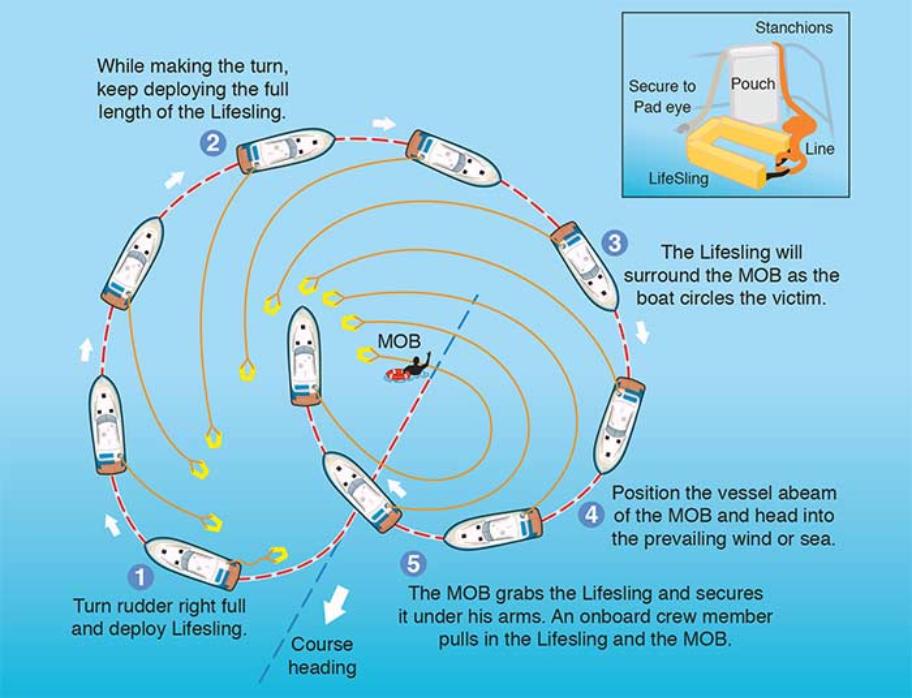
- Lift the MOB straight out of the water - This might be very effective and fast, but it will only work with low freeboard and strong person(s) aboard. Position the victim facing the boat with both arms reaching upward. If the person(s) aboard has the necessary strength, they should reach down and grasp the victim’s wrists. The victim should grab the rescuers’ wrists and the rescuers should lift the victim straight out of the water.
- Tethered dinghy (unconscious MOB) - Use a dinghy tethered to the boat with a person inside to get to the MOB and to put lifesling on to the casualty. The crew on board haul the MOB.
- Tethered swimmer (unconscious MOB) - Only as a last resort as you now have two people in the water, and potentially two victims at risk. It may work if you have a very strong swimmer aboard and the conditions are appropriate. The rescue swimmer should clip onto a spare line and enter the water with lifejacket and a face mask. He or she puts lifesling on to the casualty and the crew on board hauls the casualty.
Lift the MOB aboard
Always keep the propeller far from the casualty and lines in the water.
Methods:
- Halyard - Tie a loop (e.g. alpine butterfly) on the retrieving line 3-4 m up from the mob so that you do not have to lean overboard to find attachment point. Next, clip a spare halyard onto the loop and winch the casualty onto the vessel (you should have a spare halyard with a snap shackle and lifesling with the loop always ready to use). Alternatively, tie a bowline at the end of the halyard and lasso the mob. Halyard is a simple and effective hoisting device. With a halyard and a winch, even a small person could make a singlehanded rescue. The method is very quick, but the vertical recovery can cause hydrostatic squeeze resulting in a heart attack so if time allows. Putting an additional line under casualty knees to give a near-horizontal lift might do it. Also consider using a tackle so that you have more mechanical advantage when winching.
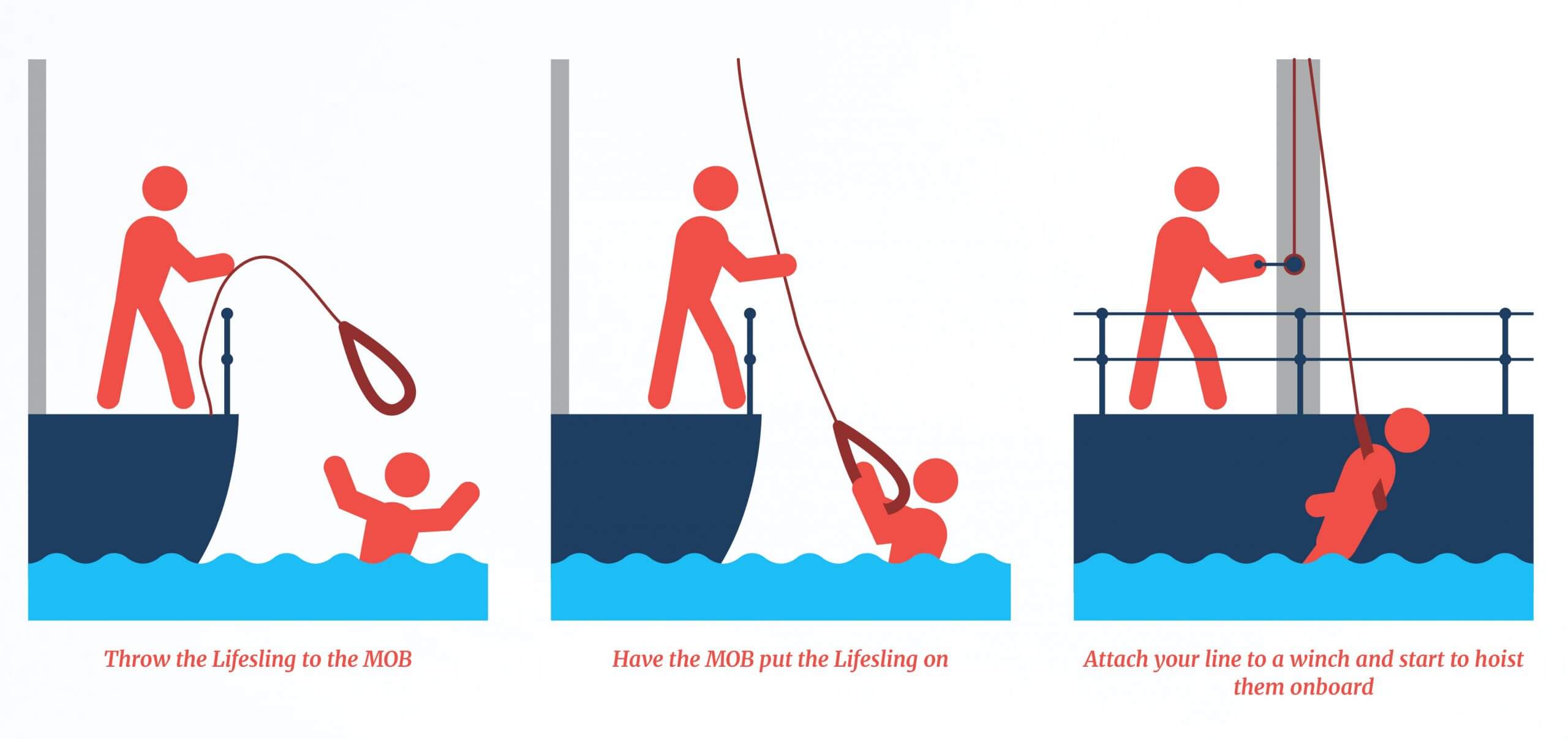
- Boarding ladder (able-bodied MOB only) - it is one of the best methods but to be effective the ladder must be rigid and have a deep step. Rope ladders are usually not effective because the swimmer’s legs swing under the hull, leaving the arms to do all the work.
- Pick-up sail or drogue - The MOB sail can be lashed with a strap-and-snap lock between the stanchions and toerail. The sailcloth sinks, and the casualty can be manoeuvred in and then brought back aboard using a halyard winch. This method is not the easiest to set up, but it can be used for an unconscious person, and it has the advantage that you lift in horizontal or near horizontal position which minimizes the risk of shock induced by sudden transfer from the water. If you do not have a specialized pick-up sail you could also use a drogue.
A very practical article and video on recovery techniques can be found in this Yachting Monthly magazine article.
Treatment
After the recovery you have to apply appropriate care for possible near drowning, hypothermia, or any other injuries.
If you fall overboard
Be aware of the Cold Water Shock. Around 60% of all drowning in colder waters (like the one found around the UK) are due to the Cold Water Shock! If you fall overboard in cold water, remember to do nothing for the first minute or so, just REST, RELAX and FLOAT.
Cold Water Shock explanation. Falling into cold water provokes an immediate gasp reflex. If your head is underwater, you'd inhale water instead of air. The initial shock can cause panic, hyperventilation, increased heart rate, and cardiac arrest in very cold water. This stage typically lasts less than a minute, and at this point, the person should concentrate on just staying afloat with their head above water until this shock passes (and it does pass). If you fail to control it, you may drown.
- Do not panic, keep your head up and do not try to swim after the boat or to the shore. If you decide to swim for shore, consider that tests show an average person wearing a lifejacket and light clothing could swim about 1.85 kilometres in the water at 10° C
- Look for something that will help you float (e.g. lifebuy) and try to conserve body heat by restricting your movements and by using the “HELP” position.
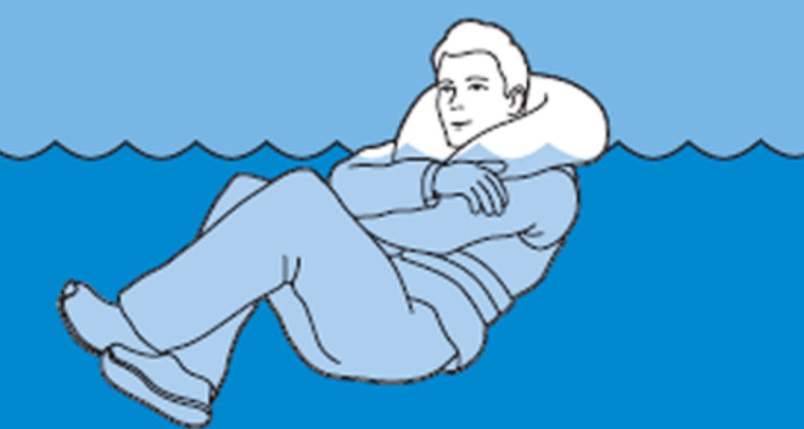
- Get your life jacket to fit as snugly as possible using the crotch and waist straps.
- Get rid of objects with negative buoyancy except for a light and knife that you may need to untangle from lines. But do not pull off clothing because it provides insulation.
- Turn the light and use a whistle to attract attention. Activate PLB and AIS MOB if you carry them.
Final note
Do not be put off by the complexities of all the above. The chances are that if you are unfortunate enough to suffer a MOB you will deal with the retrieval from your own impulses and experience, considering the conditions at hand. Use your own instinct at the time and do not try to stop and read the pages. Preparation, experience and proper equipment are all important contributors to successful survival but after all the will to survive remains the most essential factor.
Discuss and practice the procedures with your crew. When someone screams, "Man Overboard!" everyone on the crew should have a handle on what their job should be. Pull the lifesling out of its pouch and practice rigging the lifesling and hoisting someone on deck from the float or water. Go out on the water away from traffic and practice MOB rescue with a boat fender secured to a small bucket that serves as a drogue to keep it in place, and practice making turns and hoists.
Practicing may teach you that the best you can do is to stabilize the victim safely alongside and call the Coast Guard for help on the VHF. This might be fine if you are not in very cold water as it will take a relatively long time for hypothermia to develop.
Attending one of the sea survival courses is well worth it as well. In sailing, you should never stop learning.
Fair Winds and Following Seas!
- Related articles:
- Seamanship
- Safety